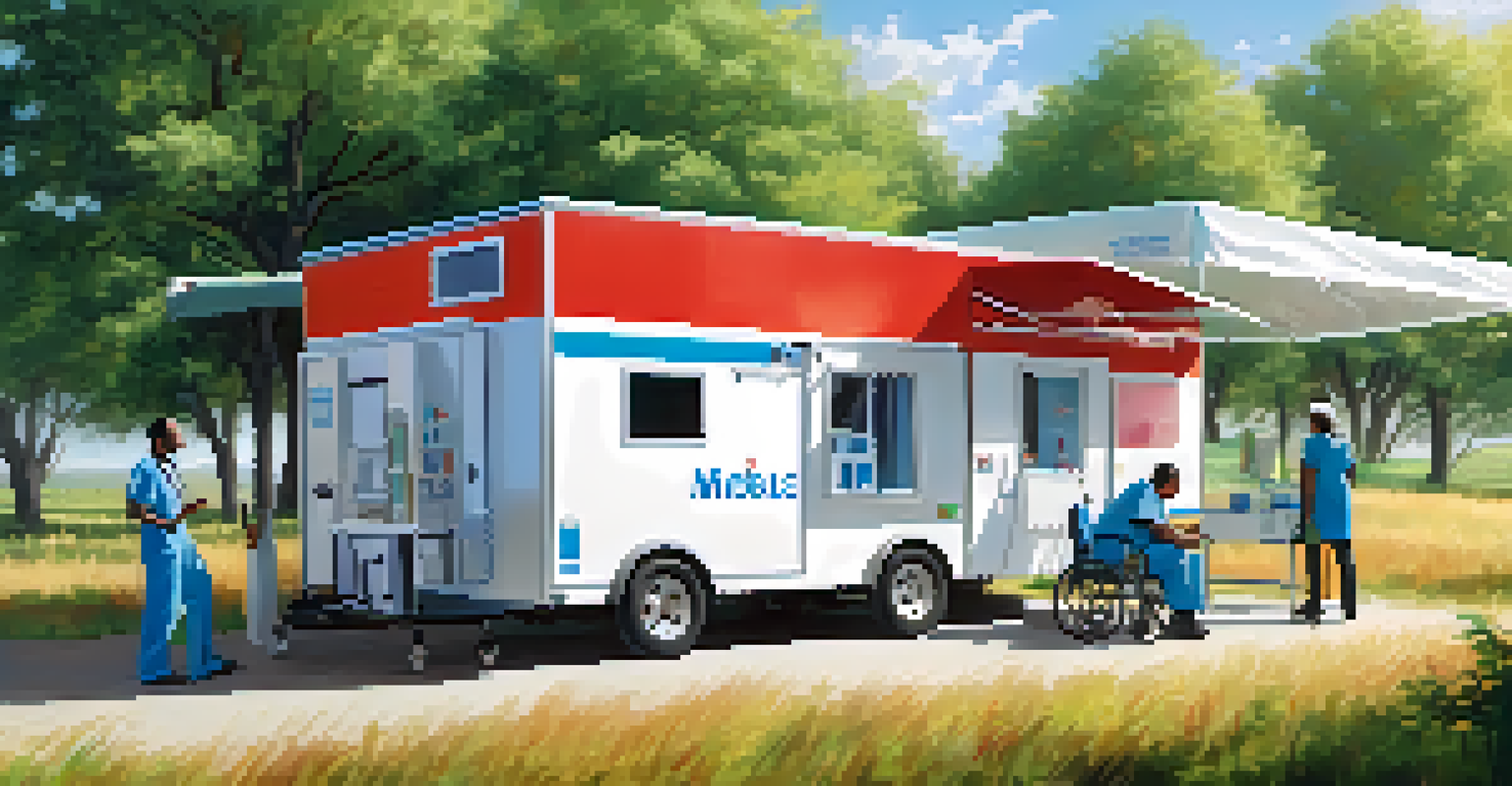Access to Healthcare for Marginalized Communities: An Overview

Understanding Marginalized Communities and Their Needs
Marginalized communities often include groups such as racial minorities, low-income individuals, and people with disabilities. These groups face unique challenges that can significantly hinder their access to healthcare. Understanding their specific needs is crucial to developing effective health policies and interventions.
Health equity is when everyone has the opportunity to be as healthy as possible, regardless of their social or economic circumstances.
For example, a person living in a rural area may struggle to find a nearby clinic, while someone facing language barriers may find it hard to communicate with healthcare providers. Such differences highlight the importance of tailoring healthcare services to accommodate diverse populations. Recognizing these disparities is the first step toward creating inclusive healthcare solutions.
Moreover, socioeconomic factors play a significant role in access to healthcare. Individuals from marginalized backgrounds often experience higher rates of chronic illnesses due to a lack of preventative care, making it vital to address these disparities head-on.
Barriers to Accessing Healthcare Services
Barriers to healthcare access can be categorized into several types: financial, geographical, and systemic. Financial barriers, such as high insurance premiums and out-of-pocket costs, often prevent marginalized individuals from seeking necessary care. For many, the fear of unexpected medical bills can deter them from making appointments.

Geographical barriers are equally significant; rural communities may lack nearby healthcare facilities, leading to long travel times for patients. Additionally, some urban areas may have clinics, but the quality of care can vary widely, further complicating access. This geographic disparity contributes to significant health inequities.
Unique Challenges for Marginalized Groups
Marginalized communities face specific barriers to healthcare, including financial, geographical, and systemic challenges that hinder access to necessary services.
Systemic barriers, including discrimination and implicit bias in healthcare settings, can also deter individuals from seeking care. When marginalized communities encounter unwelcoming environments, it can lead to mistrust and avoidance of necessary medical services.
The Role of Health Insurance in Access
Health insurance plays a critical role in determining access to healthcare services. Those without insurance are often less likely to seek preventative care or timely treatment. This lack of coverage is particularly prevalent among marginalized communities, where unemployment and underemployment can keep individuals from obtaining adequate health plans.
The greatest weapon against stress is our ability to choose one thought over another.
Even among those who are insured, the type of insurance can greatly affect access to care. Many low-income individuals may rely on Medicaid, which, while providing essential services, can sometimes limit choices of providers or lead to longer wait times for appointments. Understanding these nuances is vital for improving healthcare access.
Efforts to expand insurance coverage, such as the Affordable Care Act, have made strides in addressing these gaps. However, ongoing advocacy is needed to ensure that marginalized communities fully benefit from such programs.
Cultural Competency in Healthcare Providers
Cultural competency refers to the ability of healthcare providers to understand and respect diverse cultural backgrounds. For marginalized communities, having providers who are culturally aware can significantly improve their healthcare experiences. This understanding can lead to better communication and patient satisfaction.
For instance, a healthcare provider who speaks the same language as their patient or is familiar with their cultural practices can make the patient feel more comfortable. This comfort can encourage patients to seek care and adhere to treatment plans more consistently. It highlights the importance of diversity within the healthcare workforce.
Cultural Competency Improves Care
Healthcare providers who understand and respect diverse cultural backgrounds can enhance communication and patient satisfaction, leading to better health outcomes.
Training programs focused on cultural competency are essential for healthcare professionals. By implementing these programs, healthcare systems can foster environments that not only treat illnesses but also promote overall wellbeing among marginalized communities.
Community Health Initiatives and Their Impact
Community health initiatives play a crucial role in bridging the gap between healthcare services and marginalized communities. These programs often focus on outreach and education, making healthcare more accessible and understandable. For example, mobile clinics can bring essential services directly to underserved areas.
By involving community members in the planning and implementation of these initiatives, organizations can better address specific needs and concerns. This grassroots approach fosters trust and encourages participation, leading to improved health outcomes. Such initiatives can also provide critical resources, like health education and screenings.
The success of community health initiatives demonstrates the power of collaboration. By working together, healthcare providers and community members can develop solutions that enhance access to care and promote healthier lifestyles.
Technology's Role in Improving Access
Technology has the potential to transform healthcare access for marginalized communities. Telemedicine, for instance, allows patients to consult with healthcare providers from the comfort of their homes, eliminating geographical barriers. This can be particularly beneficial for those in remote areas or individuals with mobility challenges.
Moreover, health apps and online resources can empower patients by providing information about local services and health management tools. This access to information can encourage individuals to take charge of their health, leading to better outcomes. However, it's essential to ensure that technology is accessible to all, regardless of socioeconomic status.
Community Initiatives Enhance Access
Community health initiatives, such as mobile clinics and educational programs, effectively bridge the gap between healthcare services and marginalized populations.
While technology offers promising solutions, disparities in digital access must be addressed. Ensuring that marginalized communities have the necessary resources and skills to utilize these technologies is vital for achieving equitable healthcare access.
Future Directions for Equitable Healthcare Access
Looking ahead, addressing healthcare disparities requires a multifaceted approach that includes policy changes, community engagement, and ongoing education. Advocating for policies that expand access to services and improve health insurance coverage is crucial for marginalized communities. These changes can help level the playing field and ensure everyone receives the care they need.
Additionally, continued emphasis on cultural competency and diversity within the healthcare workforce is necessary. By fostering a healthcare environment that reflects the communities it serves, providers can build trust and improve health outcomes. Collaboration between healthcare organizations and community leaders will further enhance these efforts.

Ultimately, achieving equitable healthcare access is an ongoing journey. By prioritizing the needs of marginalized communities and implementing effective strategies, we can create a more inclusive healthcare system for all.